Paul Thomas Anderson's "The Master" - Germany-Premiere
in Panavision Super 70 | Read more at in70mm.com The 70mm Newsletter |
| Written by: Clemens Scherer. Editorial assistance: Paul Rayton. Images by: Thomas Hauerslev | Date: 15.02.2013 |
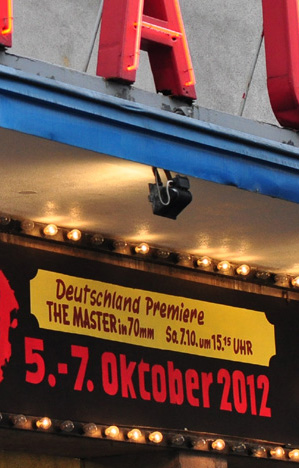 A serious occupation with presenting 70
mm-format films and all its wonders -- elements that allow for the
presentation of the film print copies in the best possible quality -- had an
extra side effect and special coincidence for the Schauburg Kino in
Karlsruhe. For a presentation within the framework of the 8.
TODD-AO Festivals (Oct. 5-7, 2012), the Schauburg had a surprise
adjustment to the calendar, being granted the honor to show the new film
from director Paul Thomas Anderson,
"The Master"
in a 70 mm print. This screening, which was the German Premiere, caused
great interest. The last times audiences had seen a narrative feature film
produced with 65 mm photography had been in 1992 for
"Far and Away"
(In einem fernen Land) and in 1996 for Kenneth Branaghs
"Hamlet".
These were long ago (at the least, 16 years!), and it had reached the point
that almost nobody on earth ever expected to see another new film with 65 mm
photography, and have it be presented through a classic 70 mm projection. A serious occupation with presenting 70
mm-format films and all its wonders -- elements that allow for the
presentation of the film print copies in the best possible quality -- had an
extra side effect and special coincidence for the Schauburg Kino in
Karlsruhe. For a presentation within the framework of the 8.
TODD-AO Festivals (Oct. 5-7, 2012), the Schauburg had a surprise
adjustment to the calendar, being granted the honor to show the new film
from director Paul Thomas Anderson,
"The Master"
in a 70 mm print. This screening, which was the German Premiere, caused
great interest. The last times audiences had seen a narrative feature film
produced with 65 mm photography had been in 1992 for
"Far and Away"
(In einem fernen Land) and in 1996 for Kenneth Branaghs
"Hamlet".
These were long ago (at the least, 16 years!), and it had reached the point
that almost nobody on earth ever expected to see another new film with 65 mm
photography, and have it be presented through a classic 70 mm projection.Followers of Mr. Anderson knew that, in planning for this movie, Mr. Anderson first thought about shooting "The Master" in VistaVision, which is a classic camera-format designed for taking pictures on film resulting in a width-to-height ratio of up to 1.85:1, with definition comparable to 65 mm, but still accomplished by using conventional 35 mm filmstocks. How well this worked in former times can be seen in, among others, the restored classic Hitchcock film "Vertigo" (1958), photographed in VistaVision, which was then restored to 70 mm prints in the early 1990s. Anderson praised especially the strong colors and textures and the full satisfaction – very obvious with "Vertigo". | More in 70mm reading: Paul Thomas Andersons "The Master" - Die Deutschland-Premiere in Panavision Super 70 "The Master" goes to Karlsruhe for 70mm Festival Photography of "The Master" in 65mm "The Master" goes to Denmark in 70mm Internet link: Senator film Cine 8-16 Schauburg.de The Master |
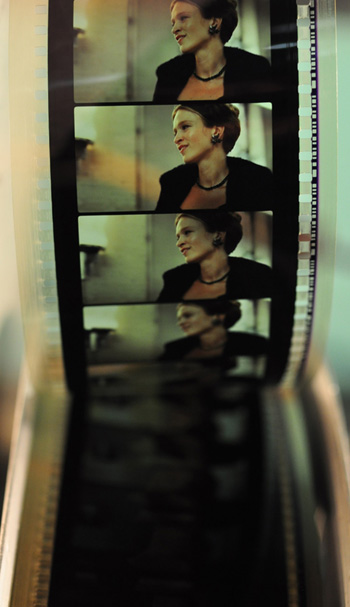 But then it turned out that with a
ready-to-operate VistaVision-Camera the results were not absolutely
convincing, so alternatively Anderson started experimenting with a 65
mm-Camera. The results were so successful that he was able to convince his
producers to let the film be photographed in
Panavision
Super 70 (which uses 65 mm film for the camera negative). But then it turned out that with a
ready-to-operate VistaVision-Camera the results were not absolutely
convincing, so alternatively Anderson started experimenting with a 65
mm-Camera. The results were so successful that he was able to convince his
producers to let the film be photographed in
Panavision
Super 70 (which uses 65 mm film for the camera negative).On October 7th, the assembled 70 mm-Experts -- plus a bunch of fans of the films of P. T. Anderson -- could actually now view this extraordinary "experiment" in a quite crowded cinema. The beginning of the movie brought a first surprise: Anderson had, in fact, composed the movie for 1.85:1 and kept this ratio, now contained within the classic, originally intended 70 mm 'wide-screen format' aspect ratio of 2.21:1. So the image is "pillarboxed" on the larger frame to be presented at the desired 1.85:1. But then it was time for the story to take its course. We see Joaquin Phoenix, who leaves no more doubt in his role as Freddie Quell -- meanwhile totally instinct driven -- that it will be impossible for his character to return to normal civic society. The images we see are clear with realistic, lively colors and no tendency toward chroma effects; simple, natural colors. Then, by chance Freddie has an encounter with Lancaster Dodd (Philip Seymour Hoffman). Dodd's "masterful" manner of handling Freddie is such that Freddie sees new aspects, giving him a new grip on life. At the same time it is a great pleasure to see Hoffman's acting. He has the stature now to be placed among the great actors of our time, and who - possibly - will be one of the last of those acting in the view field of a camera exposing the scene on 65 mm film. | |
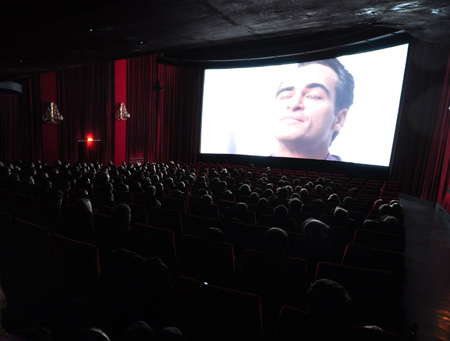 The storyline is vexing, however, as, by the time the movie concludes, the
action has no climax. Up until the end we hold some expectation that the
plot will reach some dramatic point of culmination, but this will not
happen. We have seen a section of the life of some people, some chosen
encounters, but did Anderson intend to give us a message? The storyline is vexing, however, as, by the time the movie concludes, the
action has no climax. Up until the end we hold some expectation that the
plot will reach some dramatic point of culmination, but this will not
happen. We have seen a section of the life of some people, some chosen
encounters, but did Anderson intend to give us a message?Those of us who had expected a classical 70 mm film have been probably a little bit deceived. But in follow-up discussions about the message of the film concerning the scientology-movement, and if this presentation is making such power seeking movements harmless or conscious, made for lively conversation and many opinions. | |
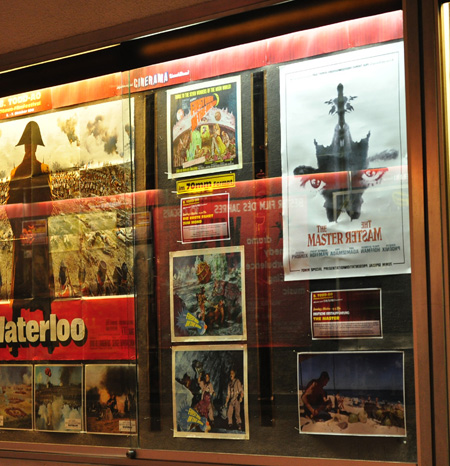 Technically speaking, those who watched the
film with special attention to the photography were particularly aware of
the fact that some scenes had a minimized 'depth-of-field'. One single sharp
object is outstandingly sharp, setting it apart from the (intentional)
blurry picture of the surroundings. This object appears 'cut out', a special
technique that is achieved best with large size photography. Anderson
himself has remarked, how much this effect so strong with 65 mm photography
has had an impact on him. He uses it to lead the view of the spectator, to
get him to pay attention to the 'cut out' face - not to the master's
outburst of fury, but to the effect of this on his adherents. Technically speaking, those who watched the
film with special attention to the photography were particularly aware of
the fact that some scenes had a minimized 'depth-of-field'. One single sharp
object is outstandingly sharp, setting it apart from the (intentional)
blurry picture of the surroundings. This object appears 'cut out', a special
technique that is achieved best with large size photography. Anderson
himself has remarked, how much this effect so strong with 65 mm photography
has had an impact on him. He uses it to lead the view of the spectator, to
get him to pay attention to the 'cut out' face - not to the master's
outburst of fury, but to the effect of this on his adherents.With classic 65/70 productions decades ago, such a minimized depth-of-field would have been considered a sacrilege! Intensive light power in correspondence with a larger f-stop number was then the key for the highly enhanced 'depth-of-field', so that the whole picture showed the highest possible resolution. Under this aspect, Anderson has really misused the format, exchanging, by choice, the exterior quality of a maximum sharpness against the inward one of leading the views by making use of the 'cut out' technique. When the message of this film is sought, one will find it the likeliest under this aspect. | |
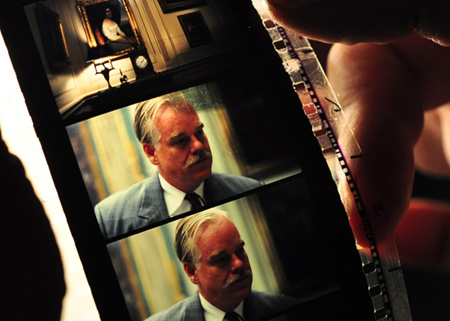 Paul Thomas Anderson pays much attention that
this 'cut out'-effect may reach as many spectators as possible. This has
been successful to the point that, to date, there have been already 16
prints of "The Master" made on 70 mm film. Anderson prefers cinemas which
can show this 70 mm format nowadays, even though they are much harder to
find than in the heyday of 70 mm projection, the 1980s. For copying he went
directly to the camera negative and cut that, to produce the 70 mm copies in
analogue contact print procedures. He avoided the possibly-easier way of
most movies today, the "D.I." (digital intermediate), the digital cut and
post-process with the final reprint of the film being a reproduction from
the digital files, or a 4K digital projection file, as was done with
"Samsara",
which was similarly photographed on 65 mm film. The digital path could have
make him loose control, as it would have become too easy to digitally
enhance that blurry content he had worked so hard to get, supposing to
'improve' but in fact destroying his work. By means of the well-tried, but
more laborious, analog process he ensures that the 70 mm copies show the
original content of the camera-negative with every included nuance. And if
we are all lucky, by coincidence the film industry will learn from this --
how to succeed really without making the compromise. Paul Thomas Anderson pays much attention that
this 'cut out'-effect may reach as many spectators as possible. This has
been successful to the point that, to date, there have been already 16
prints of "The Master" made on 70 mm film. Anderson prefers cinemas which
can show this 70 mm format nowadays, even though they are much harder to
find than in the heyday of 70 mm projection, the 1980s. For copying he went
directly to the camera negative and cut that, to produce the 70 mm copies in
analogue contact print procedures. He avoided the possibly-easier way of
most movies today, the "D.I." (digital intermediate), the digital cut and
post-process with the final reprint of the film being a reproduction from
the digital files, or a 4K digital projection file, as was done with
"Samsara",
which was similarly photographed on 65 mm film. The digital path could have
make him loose control, as it would have become too easy to digitally
enhance that blurry content he had worked so hard to get, supposing to
'improve' but in fact destroying his work. By means of the well-tried, but
more laborious, analog process he ensures that the 70 mm copies show the
original content of the camera-negative with every included nuance. And if
we are all lucky, by coincidence the film industry will learn from this --
how to succeed really without making the compromise. | |
| Go: back - top - back issues - news index Updated 22-01-25 |
